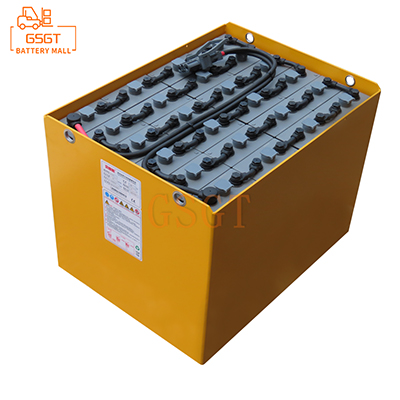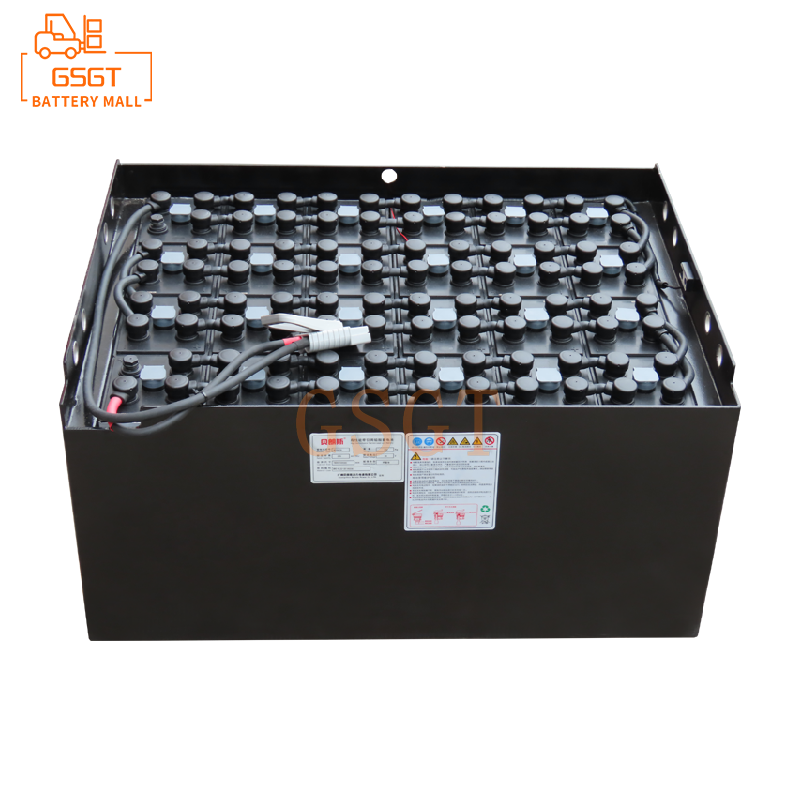Time:2025-06-18 10:29:44
Browse:623
In the modern logistics industry, forklifts, with their high efficiency and flexibility, have become indispensable equipment for warehousing and handling operations. As the power source of electric forklifts, the performance of lead-acid batteries directly affects the working efficiency and service life of the forklifts. However, during long-term use, lead-acid batteries are bound to encounter various faults. A thorough understanding of these common faults and the mastery of effective troubleshooting methods are of great significance for ensuring the normal operation of forklifts and reducing maintenance costs.
1. Overview of Lead-Acid Batteries for Forklifts
Lead-acid batteries are mainly composed of positive and negative plates, separators, electrolyte, casings, connecting bars and terminal posts, etc. Its working principle is based on an electrochemical process. During charging, electrical energy is converted into chemical energy and stored; during discharging, the chemical energy is converted back into electrical energy to provide power for the forklift. Lead-acid batteries for forklifts have the characteristics of good high-rate discharge performance, low self-discharge rate and long service life, but they also have limitations such as being afraid of vibration and having strict requirements for charging and discharging.
2. Common Faults and Troubleshooting Methods
(1) The battery power is insufficient, and the forklift cannot be started normally
1. ** Fault Phenomenon ** : When starting the forklift, the dashboard shows a low battery level, and the forklift cannot start normally. Or after starting, the driving distance is relatively short, significantly lower than the normal level.
2. **Cause Analysis**
- ** Insufficient charging ** : Short charging time, charger malfunction, poor contact of the charging line, etc. can all lead to insufficient charging of the battery.
- ** Battery aging ** : As the years of use increase, the active substances on the battery plates gradually decrease, resulting in a decline in battery capacity.
- ** Excessive self-discharge ** : Impure electrolyte, impurities in the battery casing, or internal short circuits, etc., can cause significant self-discharge in the battery even when it is not in use.
3. ** Troubleshooting Methods **
- Check the charger and charging circuit: Confirm whether the charger is working properly, whether the indicator light is on, and whether the charging voltage and current are within the normal range; Check whether the charging circuit is damaged, loose or has poor contact.
- Test battery voltage: Use a multimeter to measure the voltage of individual battery cells and the total voltage. Under normal circumstances, the voltage of a single lead-acid battery should be around 2.1V, and it can reach 2.5V when fully charged. If the voltage of a single cell is lower than 1.8V, it indicates that there is a problem with the battery.
- Check the density of the electrolyte: Use a hydrometer to measure the density of the electrolyte. For fully charged storage batteries, the density of the electrolyte should be around 1.28g/cm³ (at 25℃). If the density is too low, it indicates that the battery power is insufficient or there is a problem with the electrolyte.
- Observe the battery's appearance: Check if the battery casing has any bulges, leakage or other issues. If these problems exist, they may affect the battery's performance.
(2) Abnormal battery charging
1. ** Fault Phenomenon ** : During charging, the indicator light of the charger flashes abnormally and the charging current is unstable; Or the charging time is too long, causing the battery to heat up severely.
2. **Cause Analysis**
- ** Charger failure ** : Damage to internal components of the charger, such as problems with the rectifier, filter, controller, etc., can lead to abnormal charging.
- ** Internal battery faults ** : Internal battery faults such as sulfation of the plates, short circuits of the plates, and drying up of the electrolyte can affect the charging effect.
- ** Improper setting of charging parameters ** : Setting the charging voltage or current too high or too low can cause damage to the battery and lead to abnormal charging.
3. ** Troubleshooting Methods **
- Charger replacement test: Charge the battery with a known normal charger and observe whether the charging situation is normal to determine if the original charger is faulty.
- Check the interior of the battery: Open the upper cover of the battery and check the height of the electrolyte level. If the level is too low, add distilled water or special lead-acid battery replenishment fluid. Observe whether there are white crystalline substances (sulfidation phenomenon) on the surface of the plates. If sulfidation exists, it can be repaired by using a small current for a long time charging or a sulfidation removal charging device. Check if there is any short circuit on the plates, such as plate deformation or separator damage. If the short circuit is severe, the battery needs to be replaced.
- Verify the charging parameters: According to the specifications of the battery and the user manual, check whether the charging voltage and current Settings of the charger are correct. Make adjustments if necessary.
(3) Battery leakage
1. ** Fault Phenomenon ** : There is residual electrolyte on the surface of the battery casing, and there is a pungent smell around the battery; In severe cases, the electrolyte may corrode the forklift chassis and other components.
2. **Cause Analysis**
- ** Battery casing damage ** : During use, the battery is subjected to external forces such as collision and compression, resulting in the casing cracking and poor sealing.
- ** Poor sealing of terminal posts ** : The sealant at the connection between the terminal post and the battery casing ages and cracks, causing the electrolyte to seep out.
- ** Poor sealing of the liquid filling port cover ** : The sealing ring of the liquid filling port cover is damaged or not tightened properly, causing the electrolyte to overflow.
3. ** Troubleshooting Methods **
- Visual inspection: Carefully examine the battery casing, the area around the terminal posts, the liquid filling port cover and other parts for any signs of electrolyte leakage.
- Sealing test: Conduct a sealing test on the battery casing, which can be carried out using either the air pressure test method or the water immersion test method. If any damage to the casing is found, minor damage can be repaired with special battery repair glue. In case of severe damage, the battery casing needs to be replaced.
- Check the seals: Inspect whether the sealant of the terminal post and the sealing ring of the liquid filling port cover are aged or damaged. If there are any problems, replace the seals in time with new ones.
(4) Overheating of the battery
1. ** Fault Phenomenon ** : During the charging or discharging process, the surface temperature of the battery is too high, and it feels hot to the touch. When charging, the battery gets very hot and even smokes.
2. **Cause Analysis**
- ** Excessive charging current ** : If the output current of the charger exceeds the rated charging current of the battery, it will cause the battery to heat up.
- ** Poor heat dissipation ** : Poor ventilation around the battery or dust and debris covering the battery surface, which affects heat dissipation.
- ** Internal short circuit ** : Internal faults such as short circuit of the plates and damage to the separators will increase the internal current of the battery and generate a large amount of heat.
3. ** Troubleshooting Methods **
- Check the charging current: Use an ammeter to measure the charging current. If the current is too large, adjust the charging parameters of the charger or check if the charger is faulty.
- Clean the battery surface: Regularly clean the dust and debris on the battery surface to ensure good ventilation around the battery. Check whether the ventilation opening of the forklift battery compartment is blocked. If it is blocked, clean it in time.
- Inspect the interior of the battery: By measuring the voltage of individual battery cells, the density of the electrolyte, and other methods, determine whether there is an internal short circuit problem in the battery; If an internal short circuit is confirmed, the battery needs to be disassembled for inspection and repair. In severe cases, the battery should be replaced.
(5) Unbalanced battery voltage
1. ** Fault Phenomenon ** : When measuring the voltages of each individual battery cell, it was found that the voltage differences were significant, exceeding the normal range (generally, the voltage differences among individual cells do not exceed 0.05V).
2. **Cause Analysis**
- ** Inconsistent battery usage ** : During the usage of each individual battery, the number of charge and discharge cycles and the depth of discharge are different, resulting in inconsistent degrees of aging.
- ** Uneven electrolyte density ** : The electrolyte is added untimely or unevenly, resulting in inconsistent chemical reactions within each individual battery.
- ** Battery connection issues ** : Loose or oxidized connection strips in the battery pack can lead to uneven current distribution among individual cells.
3. ** Troubleshooting Methods **
Equalization charging: Equalization charging is carried out on battery packs with unbalanced voltages. By charging with a small current for a long time, the voltages of each individual battery tend to be consistent.
- Check the electrolyte: Measure the density of the electrolyte in each individual battery. If the density varies greatly, adjust it by adding distilled water or electrolyte with a higher density to make the electrolyte density uniform.
- Check the connection status: Inspect whether the battery pack connection strips are loose or oxidized. If there are any issues, clean the surface of the connection strips and re-tighten the connection. When necessary, replace the aged or damaged connecting strips.
3. Fault Prevention and Maintenance Suggestions
1. ** Correct charging ** : Charge strictly in accordance with the requirements of the battery user manual to avoid overcharging and undercharging. The charging environment temperature should be maintained between 5℃ and 40℃, and ventilation should be ensured during the charging process.
2. ** Regular Inspection ** : Regularly check parameters such as battery voltage, electrolyte density, and liquid level height, and promptly identify and address any issues; Check the battery's appearance for any damage, leakage or other conditions, and keep the battery surface clean.
3. ** Reasonable use ** : Avoid frequent high-current discharges to prevent excessive battery discharge; During use, try to avoid sudden acceleration, sudden braking and other operations to reduce battery wear.
4. ** Storage Management ** : If the forklift is not used for a long time, the battery should be fully charged before storage, and supplementary charging should be carried out at regular intervals to prevent self-discharge of the battery and resulting in low power.
In conclusion, the common faults of lead-acid batteries in forklifts involve multiple aspects. Through accurate judgment of fault phenomena, in-depth analysis of causes, and scientific troubleshooting methods, problems can be solved in a timely and effective manner. At the same time, doing a good job in daily prevention and maintenance can extend the service life of the battery, improve the working efficiency of forklifts, and reduce the operating costs of enterprises. In practical work, operators and maintenance personnel should constantly accumulate experience, improve their ability to diagnose and handle faults of lead-acid batteries, and ensure the safe and stable operation of forklifts.

$3405

$1060

$3050

$5710

MESSAGE
Professional And Efficient
Security
Affordable Price
Professional Services